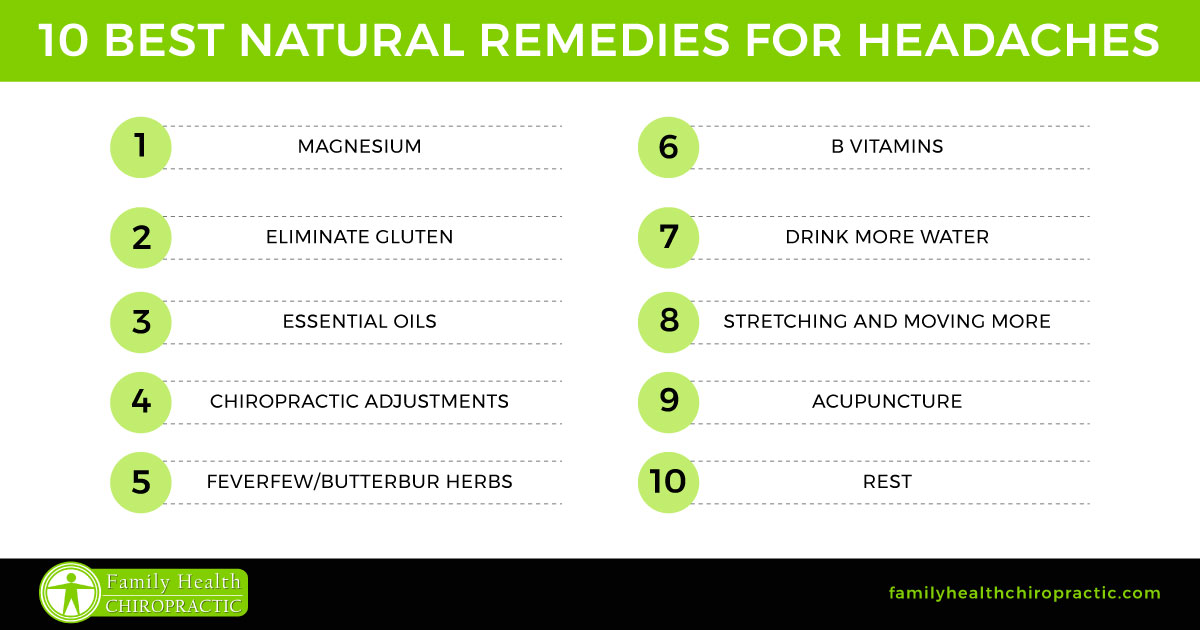Do you suffer from headaches?
Are you trying to get headache relief with over the counter medications such as Aspirin or NSAID's?
If so, you might want checkout the information I'm sharing below. As I've discussed before, taking over the counter medications can be pretty dangerous for your body.
A headache is really just a sign or symptom that your body is missing something. That something could be more rest, more water or maybe you have nutrient deficiencies from a poor diet.
Headaches can be triggered by stress, fatigue, allergies, eyestrain, poor posture, alcohol or drugs, low blood sugar, hormones, constipation and nutritional deficiencies.
Either way, take your headache as a sign that your body is telling you something needs to change.
And if you're searching for true headache relief, continuing to cover up signs or symptoms will only lead to bigger problems.
So what else can you do for headache relief? Keep reading and I'll tell you.
Common Types of Headaches
There are literally over 150 different types of headaches.
Tension Headaches:
A tension headache is the most common type of headache among adults and teenagers. Tension headaches are also known as stress headaches, chronic daily headaches or everyday headaches. They are known to cause mild to moderate chronic pain, that come and go over time.
Cluster Headaches:
These headaches are the most severe, but least common type. The pain is often described as the worst pain ever felt. Its intense and can feel like a burning or piercing pain behind the eye. Cluster headaches occur in groups over a period of time lasting from a couple of weeks to a couple of months. They may go away for months or years, but then come back.
Migraine Headaches:
Migraine headaches can last from a few hours to a few days and usually occur one or more times a month. People usually have other symptoms with migraines, including: sensitivity to light, noise or smells; nausea or vomiting; loss of appetite; and upset stomach or belly pain.
The Best 10 Natural Headache Remedies
1. Magnesium
Magnesium is one of the most successful headache relief remedies because it’s much safer than taking painkillers like aspirin, tylenol or other related NSAIDs.
People who suffer from serious headaches, like migraines or clusters, have low levels of magnesium, and several studies suggest that magnesium may reduce the frequency of migraine attacks in people with low levels.
We also know that low levels of magnesium can contribute to heart disease, blood vessel problems, diabetes and high blood pressure. All of this suggests a link between circulation and the development of headaches.
Magnesium can block the pain-transmitting chemicals in the brain, and it can improve how your body reacts to injuries and bleeding.
Taking 600-1200 mg of magnesium a day can offer amazing headache relief. Both oral and intravenous magnesium are widely available, extremely safe and inexpensive. Magnesium can be used safely by women who are pregnant. The most frequent side effect of magnesium is diarrhea, but lowering your dose or taking it less often can eliminate that issue.
To increase your daily magnesium intake, eat more fiber. Dietary sources of magnesium include beans, whole grains, seeds, nuts and vegetables like broccoli, squash and leafy greens. Dairy products, meats, chocolate and coffee also include decent levels of magnesium.
2. Reduce or Eliminate Gluten
Gluten sensitivity can lead headaches. According to the National Foundation for Celiac Awareness, patients who have undiagnosed celiac disease and migraine headaches often see either complete resolution of migraine headaches, or a significant reduction in the frequency and strength of symptoms after giving up gluten.
You can get tested or simply eliminate all forms of gluten from your diet for 30 days.
In addition, there is a spectrum of gluten sensitivity with the worst showing up as celiac disease. This means you don't have to have celiac disease but you could still have a gluten sensitivity that gives you a headache. If this is the case, you don’t have to cut out gluten completely — instead, try to cut back on your daily intake.
3. Use Essential Oils Like Peppermint or Lavender
Peppermint oil is my “go to” essential oil for headache relief. Studies have found that peppermint oil stimulates a significant increase in skin blood flow of the forehead, resulting in relaxed musculature.
Lavender oil is commonly used as a mood stabilizer and sedative. Research has shown that the use of lavender oil is a safe and effective treatment of migraine headaches. One study conducted in 2012 measured the results of inhaling lavender oil for 15 minutes. The 47 participants were asked to record the effects every half hour, for two hours. Out of 129 headache attacks, 92 responded to the lavender oil remedy.
4. Chiropractic Adjustments
Chiropractic adjustments have been shown to impact the brain in a positive way helping to improve overall organ function of the body. Not only is chiropractic care drug and surgery-free, but it's also been shown to reduce stress markers naturally.
In addition, chiropractic adjustments can act as antioxidants to repair damaged DNA.
Several clinical trials indicate that spinal manipulation therapy may help treat headaches and even offer more headache relief than medication.
In one such study, 22 percent of those who received a chiropractic adjustment reported more than a 90 percent reduction of headaches; meanwhile, 49 percent reported that the headache intensity was significantly reduced after receiving chiropractic treatment.
5. Feverfew & Butterbur Herbs
The leaves of feverfew are used to make medicine. Research has demonstrated that feverfew reduces the frequency of migraine headaches including pain, nausea, vomiting and sensitivity to light and noise.
A systematic review, completed by The School of Postgraduate Medicine and Health Science, U.K, compared the results of six studies. The results indicate that feverfew is effective in the prevention of migraine headaches and doesn’t pose any major safely concerns.
The recommended dose for headache relief is 50-100 milligrams of feverfew extract.
Butterbur is another herb that reduces the inflammatory effect of chemicals that trigger headaches, especially migraines. It also acts as a beta blocker, resulting in normal blood flow to the brain. Doses of at least 75 milligrams twice daily seem to be necessary for the best headache-reducing results.
6. B Vitamins
B vitamins are involved in the formation of brain chemicals, such as serotonin, which may be deficient in people who suffer from migraines.
Unfortunately, millions of Americans are unknowingly deficient in B vitamins, causing energy drops and fatigue, unhealthy blood cell and adrenal health, foggy thinking and headaches.
A study on mood and psychological strain associated with chronic stress measured the effectiveness of a three-month administration of two forms of high-dose vitamin B complex.
Sixty participants were involved in the trial that assessed their personality, work demands, mood, anxiety and strain.
The vitamin B complex treatment groups fared considerably better than the control group, reporting substantial lower levels of “personal strain” as well as an overall “reduction in confusion and depressed/dejected mood” after 12 weeks.
7. Drink More Water
It could be argued that one of the biggest nutrient deficiencies Western populations have, is water.
On top of simply not drinking enough water, we are consuming way more liquids that have dehydrating effects on our body. This can include coffee, sugary drinks and alcohol – all associated with headaches.
You can also quench your thirst and stay hydrated with fruits and veggies — some even have a water content that’s over 90 percent.
8. Stretching and Moving More
Staying in one position for an extended period of time, like sitting at your desk or computer, can lead to body tension and create headache symptoms.
We stare at computer screens, television monitors, smart phones, laptops and ipads. It it any wonder that we get tension headaches?
An easy way to avoid this chain reaction is to take a break every 30-60 minutes — stretch and move your head and neck around in a circular motion. This will relieve the built up stress and can help in avoiding headaches.
A 2012 study done by the Department of Physical Medicine and Rehabilitation in Finland measured the results of a stretching program for 60 women. The 12-month program resulted in a 69 percent decrease in headache frequency and symptom intensity.
So get moving!
9. Acupuncture
Acupuncture is a time tested healing and therapeutic treatment. It is over 3,000 years old and used to treat a variety of diseases and conditions. Acupuncture seeks to balance the body’s energy, or Qi, by stimulating specific points on the body. It has been proven to provide relief for chronic disease and pain.
10. Rest
I really couldn't decide whether this should be first or last on the list.
But if you're struggling with headaches, specifically migraines, then resting or simply taking a few moments to sit in a darkened room can help relieve symptoms.
If you have not yet optimized your sleep patterns, then you are slowly robbing yourself of health.




